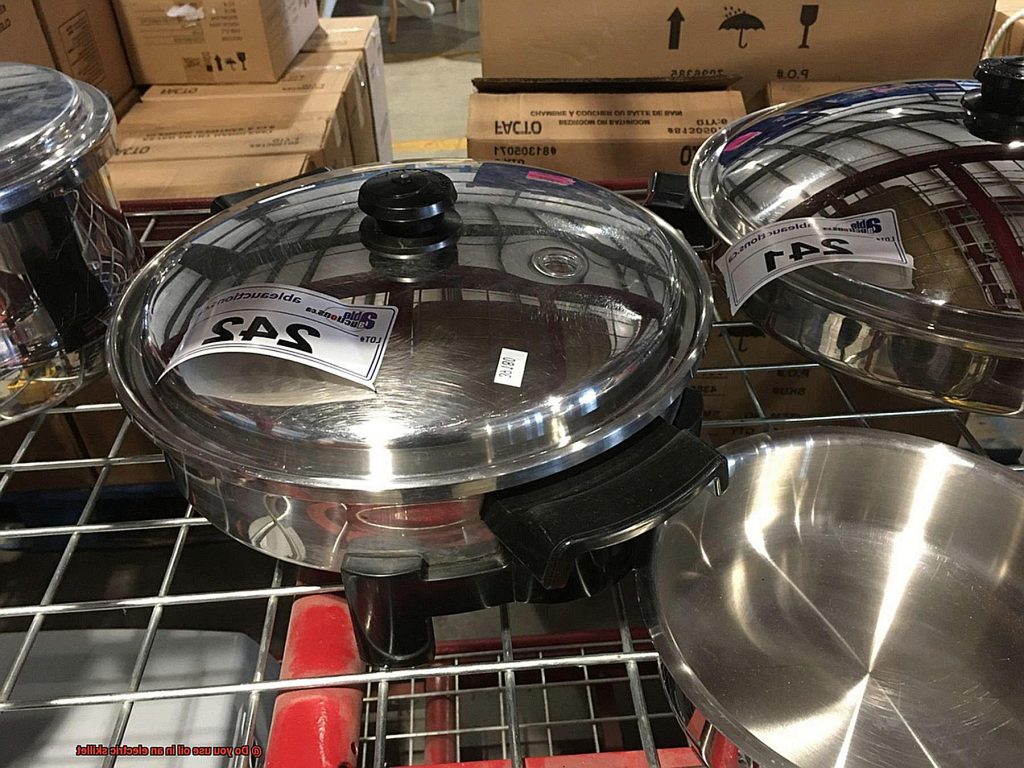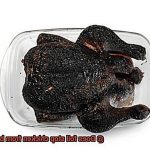Are you ready to whip up a delicious meal in your electric skillet? Before you get started, let’s talk about the importance of oil. Sure, some skillets come with non-stick surfaces, but adding a little oil or cooking spray can make all the difference in preventing food from sticking and enhancing flavor.
But here’s the catch: not all oils are created equal. Choosing the right type of oil can affect the outcome of your dish. For example, vegetable or canola oil may be better suited for high-heat cooking than olive oil which has a lower smoke point.
And let’s not forget about portion control. Using too much oil can lead to unwanted grease and extra calories, while using too little can result in dry and overcooked food. It’s all about finding the right balance.
So what should you do? Fear not. In this blog post, we’ll cover everything you need to know about using oil in an electric skillet. From the best types of oils to use to creative alternatives and portion control tips, we’ve got you covered. So grab your favorite ingredients and let’s get cooking – with confidence.
Contents
Do You Need to Use Oil in an Electric Skillet?
This is a common concern among home cooks, and the answer is not always cut and dried. There are several variables to consider when deciding whether or not to use oil.
First and foremost, consider what you’re cooking. If you’re grilling fatty foods like sausages or bacon, the natural fats in the food may suffice in preventing sticking. However, leaner meats such as chicken breasts or veggies may require a little bit of oil to avoid sticking and ensure even cooking.
Another important aspect to consider is the type of electric skillet you have. Some skillets have non-stick surfaces that require minimal to no oil, while others may need a bit more for optimal cooking results. Refer to the manufacturer’s instructions for guidance on how much oil to use with your specific skillet.
When selecting which type of oil to use in your electric skillet, keep in mind the smoke point of the oil. This is the temperature at which the oil begins to smoke and break down, creating unpleasant flavors and potentially harmful compounds. For high-heat cooking in an electric skillet, choose an oil with a high smoke point like vegetable, canola, or peanut oil.
Lastly, think about the flavor profile of the oil and how it will complement the dish you’re cooking. Olive oil has a distinctive taste that may not go well with certain dishes, whereas coconut oil can add a subtle sweetness to stir-fries and other Asian-inspired dishes.
What Type of Oil Should You Use in an Electric Skillet?
If you’re looking to whip up a scrumptious meal in your electric skillet, choosing the right oil is essential. But with so many options available, it can be overwhelming to decide which one to use. Fear not, for I am an expert on this topic and will guide you through the ins and outs of selecting the perfect oil for your electric skillet.
First things first, let’s talk about why oil is necessary in an electric skillet. It prevents food from sticking and ensures even cooking. However, using the wrong type of oil can ruin your dish. So, let’s dive into the best options.
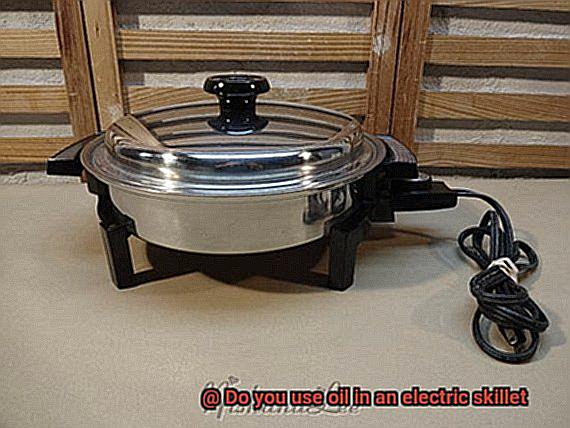
Vegetable oil is a popular choice for its versatility. It has a high smoke point, which means it won’t burn easily, making it ideal for frying and sautéing. Plus, its neutral flavor won’t overpower your dish.
Another excellent option is canola oil. With a high smoke point and a mild taste, it’s perfect for cooking foods that require high heat, like chicken or steak.
If health is a priority for you, olive oil is a great pick. It’s high in monounsaturated fat, which is good for your heart health. However, its lower smoke point makes it less suitable for high-heat cooking.
For those who enjoy unique flavors, peanut oil, sunflower oil, and sesame oil are great choices. Each has its own distinctive taste and cooking properties, so experiment with them to find the perfect match for your dish.
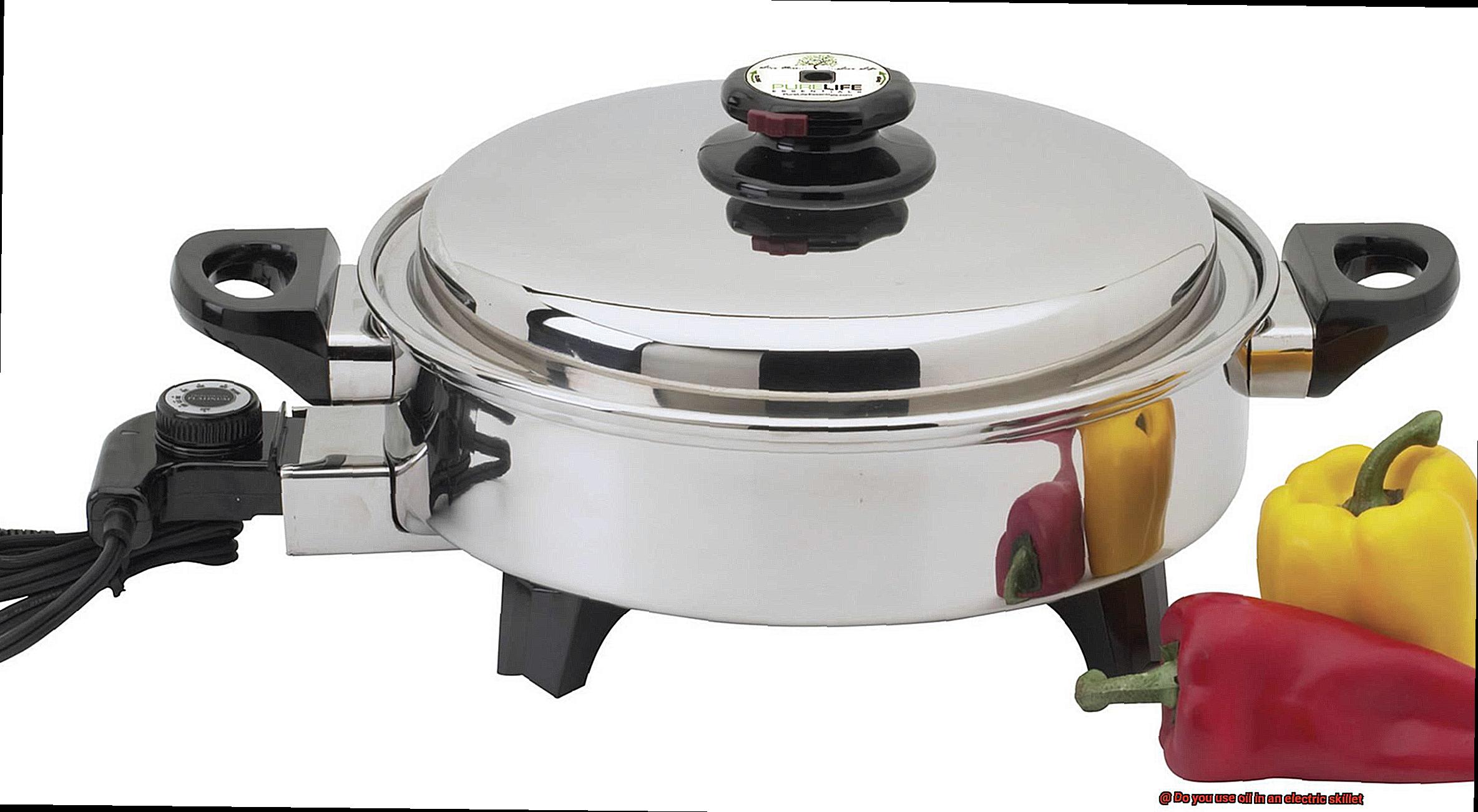
Smoke Point Considerations
Simply put, the smoke point is the temperature at which an oil begins to break down and smoke. Not only can smoking oils negatively affect the flavor of your food, but they can also release harmful chemicals. So, it’s essential to choose an oil with an appropriate smoke point for your cooking needs.
Different oils have different smoke points, with some being better suited for high-heat cooking than others. For example, refined oils like canola, vegetable, and peanut oil have higher smoke points than unrefined oils like extra-virgin olive oil and sesame oil.
When cooking at high temperatures like searing or frying, opt for an oil with a high smoke point like canola or peanut oil. For lower temperature cooking like sautéing or stir-frying, oils with a lower smoke point such as olive oil may be more suitable.
While selecting the right type of oil is important, it’s equally crucial to monitor the temperature of your skillet while cooking. Adjust the heat as needed to prevent the oil from reaching its smoke point and ensure that your food cooks evenly without becoming overcooked or burned due to smoking oils.
Flavor Profile Considerations
Then it’s time to dive into the world of flavor profile considerations. As a seasoned expert, I can attest that the type and quantity of oil used, as well as other seasonings and spices, can significantly impact the taste of your dish.
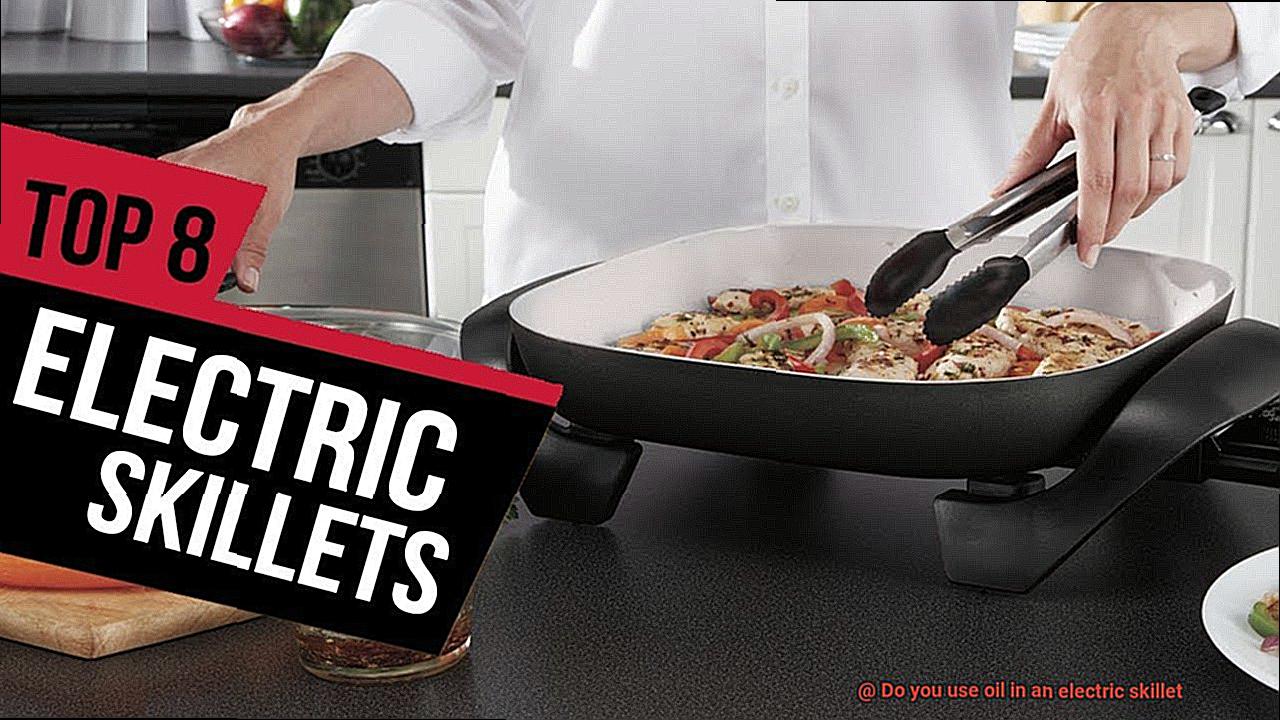
When it comes to oils, neutral options such as vegetable or canola oil are reliable for preventing food from sticking and ensuring even heating. However, if you want to add a distinctive flavor, consider experimenting with oils like olive or coconut. Keep in mind that their flavors might be too intense for some dishes, so be sure to choose wisely based on the ingredients you’re working with.
Finding the right oil quantity is equally crucial. Too little oil may result in food that’s dry and lacking in flavor, while too much oil could leave your dish feeling heavy and greasy. Therefore, it’s essential to strike a balance that complements the recipe you’re preparing.
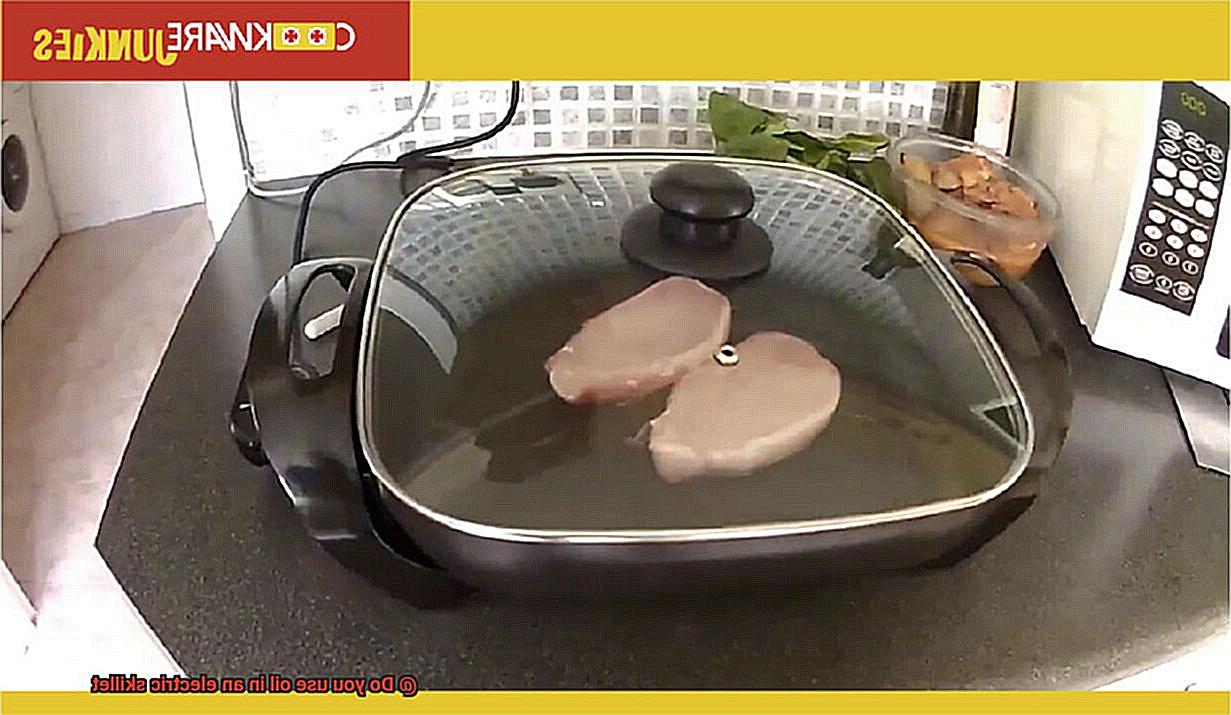
But wait, there’s more. Adding herbs like rosemary or thyme, spices like cumin or paprika, or even aromatics like garlic or ginger can help bring out the full potential of your electric skillet creations. Experiment with various combinations to find what works best for you and your taste buds.
Benefits of Using Oil in an Electric Skillet
It not only makes the cooking process easier and more efficient, but it also adds a burst of flavor and nutritional benefits to your meals.
Using oil in an electric skillet prevents food from sticking to the surface, making it a breeze to cook up sticky foods such as eggs or fish without worrying about scraping them off later. This means you spend less time cleaning up and more time enjoying your delicious meal.
But the benefits of using oil don’t stop there. By choosing the right oil for your dish, you can add a unique and delicious flavor profile to your meal. Olive oil is perfect for vegetables, while coconut oil can add a sweet and nutty taste to stir-fry dishes. The possibilities are endless, and experimenting with different oils can lead to some seriously tasty results.
Additionally, using oil in an electric skillet has potential health benefits. Certain oils like olive oil and avocado oil contain healthy fats that can help reduce inflammation in the body and lower the risk of heart disease. By incorporating these oils into your cooking routine, you’re not just making your food taste better but also doing your body some good.
It’s essential to use oil in moderation, as too much oil can lead to excess calories and unhealthy levels of fat intake. Therefore, it’s recommended to use just enough oil to coat the skillet’s surface and prevent sticking.
Tips for Adding Oil to an Electric Skillet
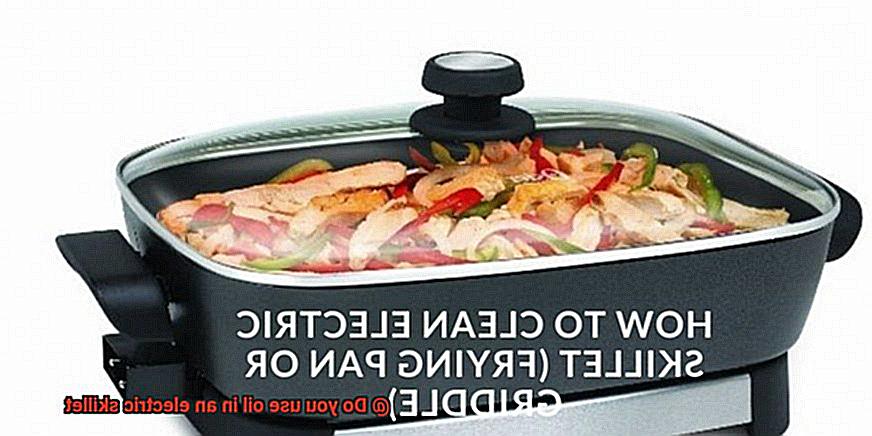
Adding oil to an electric skillet is essential for cooking various types of food. However, there are certain tips that you should keep in mind while adding oil to your electric skillet. Here are 5 sub-sections that will help you add oil safely and efficiently:
Choose the right oil
Choosing the right oil is crucial when it comes to adding oil to an electric skillet. Always go for a high smoke point oil like vegetable or canola oil to prevent any smoke or burning while cooking. Oils with a lower smoke point, like olive oil, should be avoided as they can burn easily and result in an unpleasant taste.
Use the right amount of oil
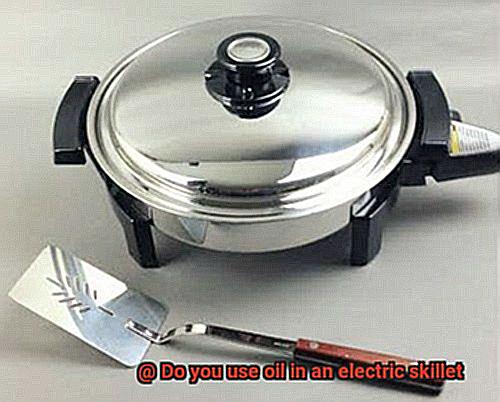
Adding too much oil to your electric skillet can cause unnecessary splattering and even be a fire hazard. A good rule of thumb is to only add enough oil to lightly coat the bottom of the skillet. This ensures that your food cooks evenly without sticking.
Preheat the skillet before adding the oil
Preheating your electric skillet before adding the oil ensures that the oil is evenly distributed and reaches its desired temperature. This helps prevent any hot spots on the skillet’s surface and ensures that your food cooks evenly.
Avoid using cooking sprays
Cooking sprays may seem convenient, but they can leave behind a residue that can be difficult to clean and may even damage the non-stick surface of your skillet over time. Instead, use a small amount of oil on a paper towel or brush to coat the surface of the skillet.
Adjust the amount of oil according to what you are cooking
Different foods require different amounts of oil. For example, vegetables and meats with higher fat content require less oil than leaner meats like chicken breast or fish. Additionally, some recipes may require you to add additional oil during cooking, so be sure to read the recipe carefully before starting.
Common Mistakes When Using Oil in an Electric Skillet
Cooking with oil in an electric skillet can be a game-changer for your favorite meals, but making common mistakes can put a damper on your culinary creations. These mistakes can lead to unevenly cooked food, burnt oil, and even dangerous fires. To help you avoid these pitfalls, we’ve compiled a list of the five most common mistakes people make when using oil in an electric skillet.
Using the Wrong Type of Oil
Choosing the wrong oil is a recipe for disaster. Different oils have different smoke points, which is the temperature at which they start to smoke and burn. Using an oil with a low smoke point, like olive oil, at high heat in your electric skillet can quickly burn and smoke. Instead, opt for oils with high smoke points like vegetable oil, canola oil, or peanut oil.
Using Too Much Oil
Using too much oil is another common mistake that can result in an oily mess and unevenly cooked food. A good rule of thumb is to use just enough oil to coat the bottom of the skillet.
Not Preheating the Skillet
Preheating your electric skillet before adding the oil is essential because it allows the oil to heat evenly and prevents sticking. If you add the oil to a cold skillet, it will take longer for it to heat up and may not distribute evenly.
Overcrowding the Skillet
Overcrowding the skillet is another common mistake people make when using oil in an electric skillet. Adding too much food to the skillet at once can cause the temperature of the oil to drop too low, resulting in unevenly cooked food. To avoid this, cook your food in batches and make sure to leave enough space between each piece of food.
Not Monitoring the Temperature
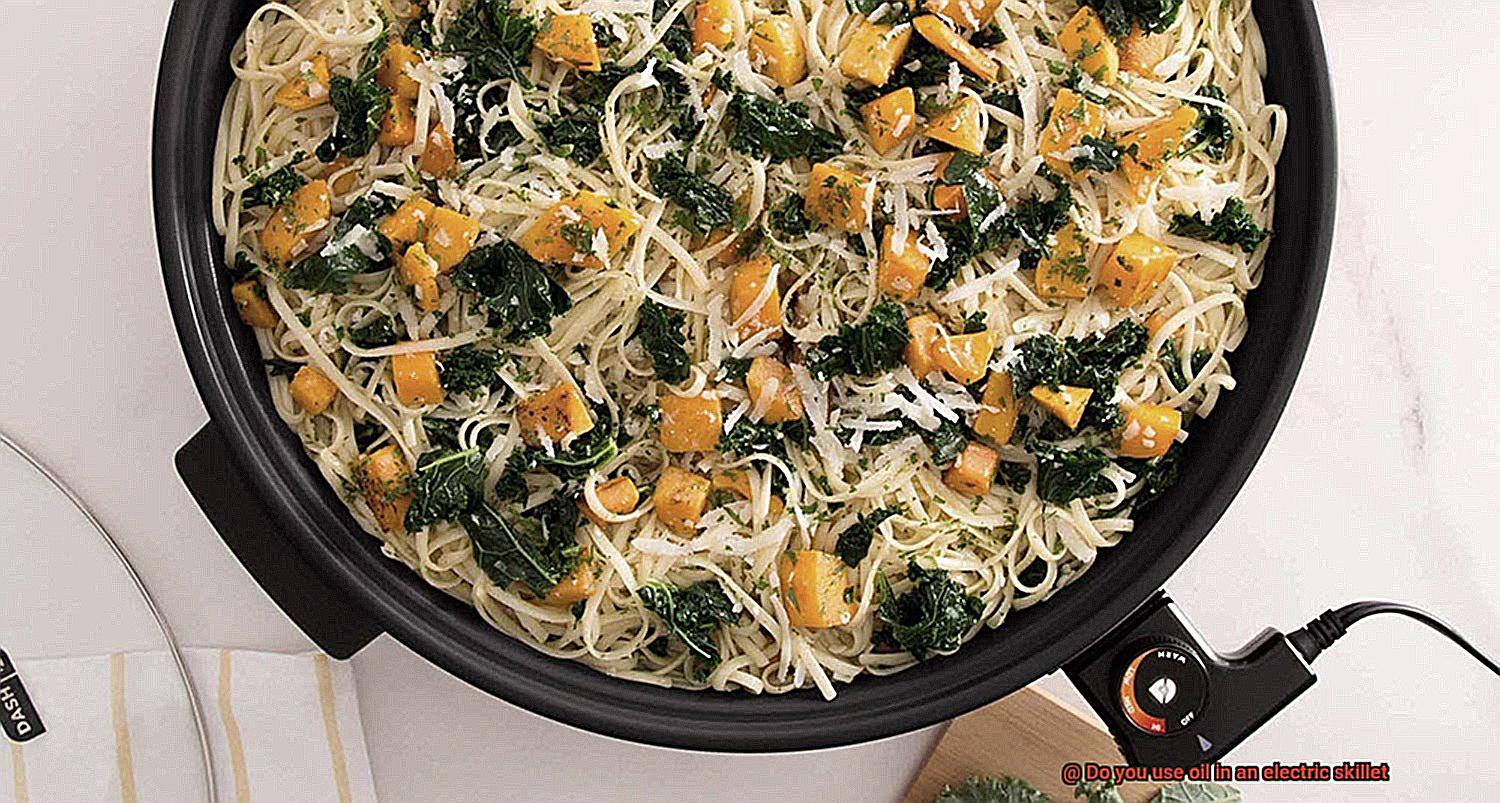
Finally, not monitoring the temperature of the oil is a common mistake people make when using oil in an electric skillet. If the temperature of the oil gets too high, it can smoke and burn, potentially causing a fire. Use a thermometer to monitor the temperature of the oil and adjust the heat as needed.
ge1zzSroXV4″ >
Conclusion
In summary, oil is a crucial ingredient in electric skillet cooking. It acts as a barrier between the food and the skillet’s surface, ensuring even cooking and preventing sticking. However, not all oils are created equal, and choosing the right type of oil can make or break your dish.
When selecting an oil for your electric skillet, consider factors such as smoke point, flavor profile, and portion control. Vegetable or canola oil works well for high-heat cooking, while olive oil is better suited for lower temperature cooking. And don’t be afraid to experiment with unique oils like peanut or sesame to add a distinct taste to your dishes.
Moderation is key when it comes to using oil in an electric skillet. Using just enough to coat the surface will prevent sticking without adding unnecessary calories. Plus, using the right amount of oil has potential health benefits such as reducing inflammation and lowering the risk of heart disease.
To avoid common mistakes when using oil in an electric skillet, follow these simple tips: choose the right type of oil for your recipe, use the appropriate amount of oil, preheat the skillet before adding oil, avoid overcrowding the skillet, and monitor the temperature closely.
By incorporating these guidelines into your electric skillet cooking routine, you’ll be able to whip up delicious meals with ease.

